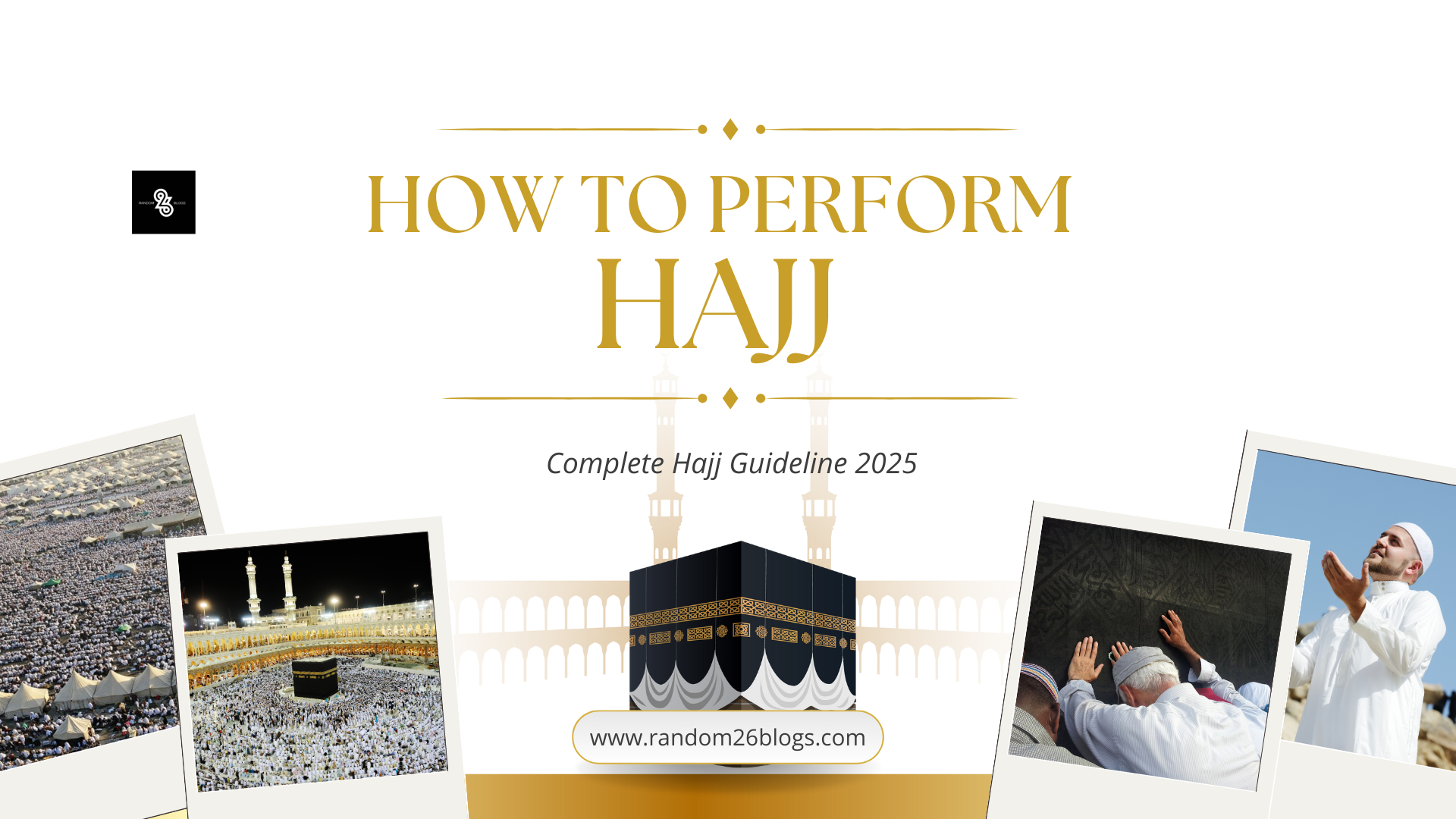
Planning to perform Hajj in 2025? This step-by-step guide with detailed rituals, common mistakes, and FAQs will help you fulfill this sacred obligation correctly, Insha’Allah.
Table of Contents
Hajj: A Sacred Obligation and Spiritual Journey
Hajj, one of the five pillars of Islam, is a mandatory act of worship for every physically and financially capable Muslim. This profound pilgrimage to the holy city of Makkah serves as a transformative spiritual experience, drawing believers closer to Allah, renewing their faith (Iman), and offering an unparalleled opportunity to seek divine mercy and forgiveness.
Key Dates for Hajj 2025
The rituals of Hajj occur annually from the 8th to the 13th of Dhul Hijjah. In 2025, Hajj is projected to begin on 4th June and conclude on 9th June, Insha’Allah.
Why Proper Preparation Matters
Performing Hajj correctly requires meticulous preparation. Understanding the rituals in advance ensures adherence to the Sunnah, minimizes errors, and allows pilgrims to fully immerse themselves in worship. This guide outlines the essential steps, types of Hajj, and preparatory measures to help you fulfill this sacred duty with confidence.
Types of Hajj
Hajj can be performed in three distinct ways, each with specific rituals:
1. Hajj Tamattu (Recommended)
- Description: Combines Umrah and Hajj with a temporary release from Ihram in between.
- Rituals:
- Perform Umrah (Tawaf and Sa’i) during the Hajj months.
- Exit Ihram after Umrah.
- Re-enter Ihram on the 8th of Dhul Hijjah to begin Hajj.
- Sacrifice (Qurbani): Mandatory.
- Significance: The Prophet Muhammad ﷺ performed this type during his Farewell Hajj, making it the most recommended method.
2. Hajj Qiran
- Description: Combines Umrah and Hajj in a single, continuous Ihram.
- Rituals:
- Enter Ihram for both Umrah and Hajj simultaneously.
- Remain in Ihram until all rituals are completed.
- Sacrifice (Qurbani): Obligatory.
- Suitability: Ideal for those who can endure the extended state of Ihram.
3. Hajj Ifrad
- Description: Focuses exclusively on Hajj without incorporating Umrah.
- Rituals:
- Enter Ihram for Hajj alone.
- Sacrifice (Qurbani): Not required.
Essential Hajj Preparation Checklist
Before embarking on your journey, ensure the following:
- Choose Your Hajj Type: Decide between Tamattu, Qiran, or Ifrad.
- Logistical Arrangements:
- Book through a government-approved Hajj agency.
- Secure flights, accommodation, and transportation in Saudi Arabia.
- For women: Arrange for a Mahram (male guardian) to accompany you.
- Educational Preparation:
- Study the rituals, duas, and common challenges of Hajj.
- Attend pre-Hajj workshops or consult reliable Islamic resources.
- Spiritual Readiness:
- Repent sincerely for past sins.
- Settle debts and resolve disputes.
- Physical Readiness:
- Pack essentials: Ihram clothing, toiletries, medications, and comfortable footwear.
- Prepare for extreme heat and physical exertion.
By understanding the types of Hajj and meticulously preparing, you can approach this sacred journey with clarity and devotion. May Allah grant you the strength to perform Hajj with sincerity and accept it as an act of pure worship. آمِينَ!
Step-by-Step Guide to Performing Hajj

Step 1: Niyyah (Intention)
- Make a sincere intention in your heart to perform Hajj solely for Allah’s sake.
Step 2: Enter Ihram
- Miqat Points: Enter Ihram at one of five designated locations:
- Dhu’l-Hulayfah (for those coming from Madinah).
- Al-Juhfah (for pilgrims from Syria, Egypt, etc.).
- Yalamlam (for those from Yemen, South Asia).
- Qarn al-Manazil (for pilgrims from UAE, Malaysia, etc.).
- Dhat ‘Irq (for those from Iraq, Iran).
- Ihram Clothing:
- Men: Two unstitched white sheets.
- Women: Modest, loose-fitting clothing (no face cover unless non-Mahram are present).
- Restrictions:
- No cutting hair/nails, using perfume, or intimate relations.
- Avoid arguments or sinful acts.
Step 3: Recite Talbiyah
- Dua:
لَبَّيْكَ اللَّهُمَّ لَبَّيْكَ، لَبَّيْكَ لَا شَرِيكَ لَكَ لَبَّيْكَ، إِنَّ الْحَمْدَ وَالنِّعْمَةَ لَكَ وَالْمُلْكَ، لَا شَرِيكَ لَكَ
“Labbaik Allahumma labbaik, labbaik la sharika laka labbaik. Innal-hamda wan-ni’mata laka wal-mulk, la sharika lak.”
(“Here I am, O Allah, here I am. You have no partner. All praise and blessings are Yours.”)
Day 1 (8th Dhul Hijjah): Tarwiyah Day
- Tawaf al-Qudum: Circle the Kaaba 7 times.
- Sa’i: Walk between Safa and Marwa 7 times.
- Proceed to Mina: Stay overnight and pray Dhuhr, Asr, Maghrib, Isha, and Fajr.
Day 2 (9th Dhul Hijjah): Arafah Day
- Depart for Arafah: After Fajr, travel to Arafah while reciting Talbiyah.
- Wuquf (Standing at Arafah):
- Listen to the Khutbah at Masjid al-Namirah.
- Pray Dhuhr and Asr combined.
- Supplicate until sunset.
- Proceed to Muzdalifah: Collect pebbles for Rami and pray Maghrib + Isha.
Day 3 (10th Dhul Hijjah): Eid al-Adha
- Rami al-Jamarat al-Aqabah: Throw 7 pebbles at the largest pillar.
- Sacrifice (Nahr): Slaughter an animal (obligatory for Tamattu/Qiran).
- Halq/Taqsir: Shave or trim hair (men shave fully; women trim a fingertip-length).
- Tawaf al-Ifadah: Perform Tawaf and Sa’i again.
Days 4–5 (11th–12th Dhul Hijjah): Days of Tashreeq
- Rami All 3 Jamarat: Throw 7 pebbles at each pillar (21 total daily).
- Stay in Mina: Depart for Makkah before sunset on 12th Dhul Hijjah.
Final Step: Tawaf al-Wida (Farewell Tawaf)
- Perform a final Tawaf before leaving Makkah.
Common Mistakes Pilgrims Make
- Shouting Duas in Unison: Supplicate individually, not collectively.
- Leaving Arafah Early: Stay until sunset.
- Trimming Hair Before Sa’i: Complete Sa’i first.
- Selfies/Videos: Avoid distractions; focus on worship.
- Assuming Jamarat = Shaytan: It’s symbolic; avoid superstitions.
Frequently Asked Questions (FAQs)
Q: Can I ask someone to make dua for me during Hajj?
A: Yes! The Sahaba (RA) practiced this. Example: Safwan bin Abdullah (RA) was asked to pray for others.
Q: Why circle the Kaaba 7 times?
A: It’s a Sunnah established by the Prophet ﷺ, symbolizing unity and devotion.
Q: What invalidates Hajj?
A: Intentionally violating Ihram restrictions (e.g., intimacy, cutting hair).
Q: Is visiting Madinah required?
A: No, but most pilgrims visit to pray at Masjid an-Nabawi and greet the Prophet ﷺ.
Hajj
Hajj is a life-changing journey that purifies the soul and strengthens faith. By following this guide, you can perform Hajj correctly and avoid common pitfalls. May Allah accept your Hajj as Hajj Mabrur and grant you forgiveness. Share this guide to help others prepare!
أَسْأَلُ اللَّهَ أَنْ يَتَقَبَّلَ مِنَّا وَمِنْكُمْ
“I ask Allah to accept (Hajj) from us and from you.”
Need More Guidance?
© 2025 Random26 Blogs |
SOME MORE Internal Suggestions:






